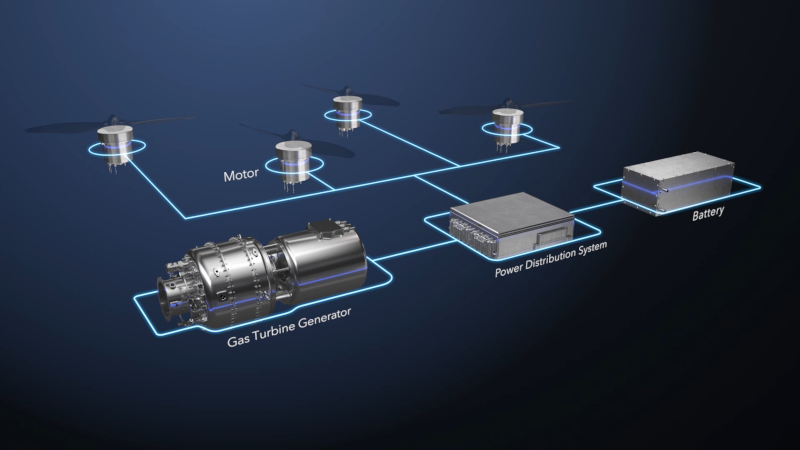In a world increasingly driven by the quest for sustainable and efficient urban transport solutions, Honda is setting the pace with its latest venture into the electric vertical take-off and landing (eVTOL) market. With a legacy that spans both the highways and the skies, Honda is harnessing its storied history of innovation to craft an eVTOL aircraft that promises to redefine the urban air mobility landscape.
The Strategic Vision Behind Honda's eVTOL Initiative
Honda's eVTOL project is part of a larger strategy to create a comprehensive mobility ecosystem that integrates aerial and ground transportation solutions. This ecosystem aims to enhance travel freedom and efficiency, making urban air mobility more accessible for various applications beyond business travel, including commuting tourism and emergency transport.
Leveraging Honda's Aerospace and Automotive Expertise
Honda's foray into the eVTOL market is bolstered by its formidable automotive and aerospace expertise. The company's proven track record in mass-producing vehicles with high safety standards and consumer usability will undoubtedly influence the design and production of its eVTOL aircraft. Additionally, the insights gained from the development and certification of the HondaJet provide Honda with invaluable knowledge of aviation regulations and certification processes.
Hybrid Power Unit: A Competitive Edge
Honda's approach to eVTOL design emphasizes safety, quiet operation, and passenger comfort. A key feature of Honda's eVTOL is its gas turbine hybrid power unit, which extends its operational range to about 400 km (approximately 250 miles); this surpasses many all-electric counterparts and could make it the ideal solution for inter-city travel.
 Honda's eVTOL is its gas turbine hybrid power unit
Honda's eVTOL is its gas turbine hybrid power unit
This hybrid system combines a gas turbine generator with batteries to power motors for lift and The use of eight rotors for vertical take-off and landing and two for propulsion, ensuring redundancy and safety, ensuring efficient take-off and landing while enabling the aircraft to switch to motor power for cruising and battery recharging.

The gas turbine in Honda's eVTOL serves as a generator, converting the fuel's chemical energy into electrical energy. This electricity powers the electric motors responsible for propelling the aircraft. One of the primary advantages of this setup is the potential for extended range and increased payload capabilities compared to purely battery-powered systems, which are currently limited by the energy density of available battery technologies.

Moreover, using a gas turbine, Honda's eVTOL can leverage the existing aviation fuel infrastructure, easing the transition from conventional to electric aircraft. This hybrid approach also opens the door for the use of sustainable aviation fuels (SAFs), which can significantly reduce the carbon footprint of air travel.
Integrating a gas turbine hybrid power unit in an eVTOL reflects a broader industry trend towards hybrid propulsion systems as a viable intermediate step towards fully electric, zero-emission air transport. This technology not only addresses the current limitations of electric flight but also aligns with global efforts to make aviation more sustainable.
Branding and Market Positioning
It remains to be seen whether Honda's eVTOL will be marketed under the HondaJet brand or if the company will opt for a new branding strategy to distinguish its urban air mobility offerings. Regardless of the branding decision, Honda's entry into the eVTOL market is a strategic move that aligns with its "Vision 2030" goals. These goals encompass a commitment to innovation, achieving zero environmental impact, and exploring new frontiers in mobility, including the potential for space.
Honda Gears Up for Stiff Competition in the eVTOL Market:
The eVTOL market is increasingly competitive, with numerous companies vying for urban air mobility space leadership. Honda's entry will contend with projects like Volocopter's VoloCity, Lilium Jet, and Airbus's CityAirbus, each offering unique capabilities. However, Honda's hybrid propulsion system differentiates its eVTOL by providing a more extended range and higher efficiency than many all-electric alternatives, offering a viable solution for inter-city transportation.
- Sirius Aviation Business Jet: A hydrogen-electric powered eVTOL, targeting an impressive range and high cruise speed, offering a sustainable alternative for urban air mobility
- Volocopter's VoloCity: A two-passenger eVTOL with a range of 22 miles and a cruise speed of 68 mph, expecting commercial launch around 2024-2025.
- Lilium Jet: This aircraft has a range of 186 miles and a cruise speed of 186 mph. It can seat one pilot and four passengers and is targeted for a 2025 launch.
- Wisk's Cora is an autonomous two-passenger air taxi with a 25-mile range and 100 mph cruise speed, developed as a joint venture between Boeing and Kitty Hawk.
- Airbus's CityAirbus Demonstrator: A four-passenger eVTOL with a 60-mile range and 75 mph cruise speed, part of Airbus's urban air mobility efforts.
- Ehang's EH216 is a two-passenger eVTOL with a 21-mile range and 83 mph cruise speed. It is involved in various urban air mobility initiatives in Europe.
|
Aircraft |
Passenger Capacity |
Range (miles) |
Cruise Speed (mph) |
Launch Target |
Power Type |
|
Honda eVTOL (Upcoming) |
TBD |
TBD |
TBD |
TBD |
Hybrid (Gas turbine + Electric) |
|
Volocopter's VoloCity |
2 |
22 |
68 |
2024-2025 |
Electric |
|
Lilium Jet |
1 pilot + 4 passengers |
186 |
186 |
2025 |
Electric |
|
Wisk's Cora |
2 |
25 |
100 |
TBD |
Electric |
|
Airbus's CityAirbus Demonstrator |
4 |
60 |
75 |
TBD |
Electric |
|
Ehang's EH216 |
2 |
21 |
83 |
TBD |
Electric |
|
Sirius Aviation Business Jet |
Up to 3 |
1150 |
323 |
TBD |
Hydrogen-Electric |
Towards a Comprehensive Mobility Ecosystem
Honda's ambition extends beyond individual eVTOLs to creating an integrated mobility ecosystem that includes various transport layers, from ground to air. This ecosystem aims to reduce travel times, offer more pleasant mobility experiences, and potentially revolutionize the concept of mobility by integrating with public transportation systems.
This ecosystem is not merely about introducing an electric vertical take-off and landing (eVTOL) aircraft; it's about creating a seamless, integrated network bridging the gap between aerial and ground transportation, offering unparalleled efficiency, accessibility, and sustainability. To understand this vision in greater depth, we can explore its foundational elements, potential execution strategies, and the benefits it aims to deliver to users.
Multimodal Transportation Integration:
At the heart of Honda's vision is integrating different modes of transportation. This includes the eVTOL for air travel, traditional vehicles for road transport, and even public transportation systems. The goal is to create a seamless experience where users can effortlessly transition from one mode to another, tailored to their specific journey requirements. By seamlessly integrating aerial and ground transportation, Honda's ecosystem aims to significantly reduce travel times, making distant or hard-to-reach destinations more accessible. This could transform daily commutes, making them faster and less stressful.
In essence, Honda's larger mobility ecosystem vision seeks to break down the silos that currently exist between different forms of transportation, offering a unified, efficient, and sustainable solution. While the realization of such a vision is undoubtedly challenging, it has the potential to dramatically transform the urban landscape and the way we think about mobility.
By combining its vast expertise in hybrid technology, safety, and auto and aerospace manufacturing, Honda is positioning itself as a significant player in the future of transportation. It aims to make the skies an accessible and efficient pathway for connecting people and places. As the eVTOL market evolves, Honda's unique approach and technological capabilities may set a new benchmark in urban air mobility.





